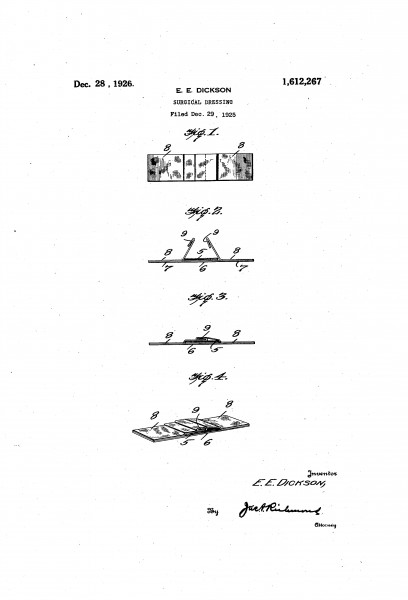BAND-AID® Brand Adhesive Bandages on CBS Sunday Morning!

BAND-AID® Brand Adhesive Bandages were featured on the CBS Sunday Morning annual design show, Sunday Morning by Design, on May 31st. An iconic consumer product and a design classic, BAND-AID® Brand Adhesive Bandages are instantly recognizable as a symbol of caring for 94 years.
You can watch the show on the CBS website at this link.
The show focused on design and the role it plays in so many aspects of our lives – from places, to comedy, to everyday items, to health care. One of the themes of the show was how design can change the world.

In the BAND-AID® Brand segment, Sarita T. Finnie, Senior Director, Compromised Skin GFO in our consumer operating company, took CBS This Morning on-air correspondent Susan Spencer through the history of the BAND-AID® brand, starting with the product’s invention by cotton buyer Earle Dickson in 1920 to help his wife and its introduction in 1921, to its inclusion in The New York Times list of greatest all-time innovations in 2013, to today. Sarita explained the staying power of BAND-AID® Brand Adhesive Bandages, the first pre-made commercial dressing for small wounds: “A good design will solve a problem, but a great design is intuitive and simple and timeless," she explained.

In fact, BAND-AID® Brand Adhesive Bandages are such a great design (and a great innovation) that it seems unthinkable that there was ever a time without them. Before Johnson & Johnson put them on the market in 1921, people tried a variety of makeshift and not very successful ways to protect small cuts and scrapes, such as tying strips of fabric or gauze around their fingers.

The product was such a new concept when it launched that Johnson & Johnson had to show people how to use it. Since then, BAND-AID® Brand Adhesive Bandages helped sponsor a groundbreaking 1950s television show, they have gone to the Moon with the Apollo 11 astronauts and into World War II with soldiers, they’ve had a song written for them by Barry Manilow (“I am Stuck on BAND-AID® Brand…”), and they’ve been decorated with beloved cartoon characters and by leading designers. Through that evolution, the brand has continued to innovate, using more advanced designs and materials as technology and science have progressed over the decades since their invention. The product is such a design icon that it’s featured in the permanent design collection of the Museum of Modern Art. (Their website lists Earle Dickson as the artist!)

We sent a range of historical BAND-AID® Brand Adhesive Bandage tins, ads and images (including the original patent for the product, which was shown on-air!) from the Johnson & Johnson archives to CBS This Morning for the story.

The tins each reflect their particular decade in a number of ways, from the forward-looking new possibilities of the 1920s square tin, to the intricately designed 1930s tin, to the clean, simple lines of the 1940s and 1950s, to the Pop Art Sheer Strips tin of the 1960s, to the neon colors of the 1980s. These tins – as iconic as the product they held – were like honorary members of the family in the medicine cabinets of generations of households, and their design was so valuable that they were repurposed in sewing boxes, workshops and toy chests to hold a variety of items that people wanted to protect and keep safe.

The historical ads were matched to the tins we sent, and included some of the earliest BAND-AID® Brand Adhesive Bandages ads that demonstrated how to use the newly-introduced product. They included 1940s ads that showed the ways in which the product was there to protect not only families but soldiers.

The 1960 Saturday Evening Post ad for the new BAND-AID® Brand Adhesive Bandages in extra large size proclaimed “Need this many? Try this," an example of design as part of the product’s innovation throughout its history.

BAND-AID® Brand Adhesive Bandages continue to evolve and innovate since their invention in 1920, with new ways to heal and protect wounds, with new designs and even with an app (the Muppets MAGIC VISION™ mobile app). But the same basic idea that motivated Earle Dickson – designing an easy to use, effective premade dressing to help people – remains the same today.
Again, the segment is at this link on the CBS website.

I always have a few Band-Aids with me, safely tucked into my wallet. It makes me happy to be able to share with someone who needs one.
I've used Band-Aid brand adhesive strips of all sizes most of my life (I'm 69 yrs. old) and for my children and grandchildren. I've tried others - not quite as good. But I've had a problem with one particular aspect of the design. Since I am a part-time handyman these days (and I have always been pretty handy), I tend to need band-aid strips for my fingers and hands quite often. the problwem is that standard band-aid strips tend to be too short in length to wrap around the thickness of most of my fingers. I used to have to use two band-aid strips in order to keep my bruises covered. Now I usually use some surgical adhesive tape wrapped around and over the band-aid. All you need is a band-aid strip a little longer (about 3/4 in.) for us thick fingered guys.
I carry band-aids in my tool kit with some antiseptic cleanser and ointment so I can clean & cover up any cuts as they occur. A longer strip would stay on where the current standard size will fall off after a short time. Let me know what you think; if it's a good idea.
I found very cool band-adis when I was in US. Ones that we do not have in Brazil. very cool! :)